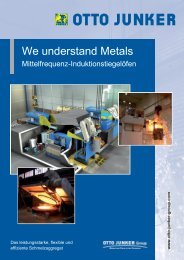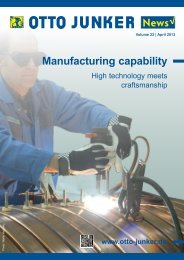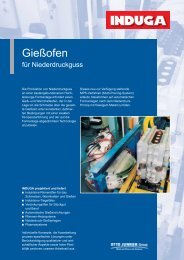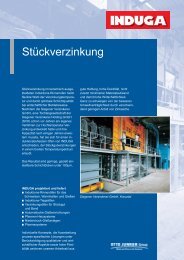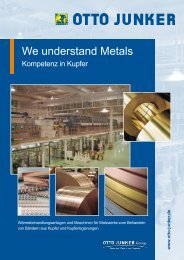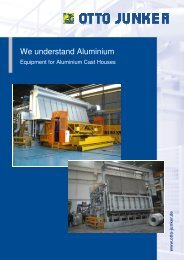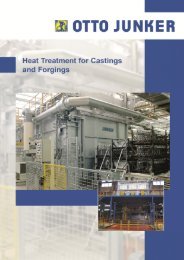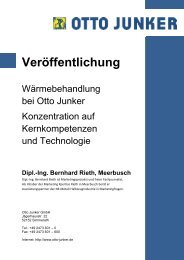SLE Pusher Furnace_E - Otto Junker GmbH
SLE Pusher Furnace_E - Otto Junker GmbH
SLE Pusher Furnace_E - Otto Junker GmbH
Create successful ePaper yourself
Turn your PDF publications into a flip-book with our unique Google optimized e-Paper software.
Publication<br />
<strong>SLE</strong> <strong>Pusher</strong> <strong>Furnace</strong> ®<br />
Side Loaded Energy<br />
Saving <strong>Pusher</strong> <strong>Furnace</strong> ®<br />
Dipl.-Ing. Bernd Deimann<br />
Head of Projecting and Sales - <strong>Furnace</strong> Equipment and Machinery<br />
for Aluminium Rolling Mills<br />
<strong>Otto</strong> <strong>Junker</strong> <strong>GmbH</strong>, Simmerath<br />
<strong>Otto</strong> <strong>Junker</strong> <strong>GmbH</strong><br />
Jägerhausstr. 22<br />
52152 Simmerath<br />
Tel.: +49 2473 601 – 0<br />
Fax: +49 2473 601 – 600<br />
Internet: http://www.otto-junker.de
2 / 7<br />
<strong>SLE</strong> <strong>Pusher</strong> <strong>Furnace</strong> ®<br />
Side Loaded Energy Saving <strong>Pusher</strong> <strong>Furnace</strong> ®<br />
A new generation pusher furnace for pre-heating and homogenizing<br />
aluminium slabs prior to hot rolling<br />
1. Introduction<br />
In aluminium hot-rolling, the slabs to be rolled are preheated to a 400 – 550 °C rolling<br />
temperature or else homogenized over a prolonged soak period at around 600 °C and then<br />
cooled down to this rolling temperature before entering the mill.<br />
This process is carried out mainly with the aid of pusher furnaces, pit furnaces or - in rare<br />
cases –, bogie hearth or chamber-type furnaces. For new facility projects, the pit furnace<br />
plays a lesser role than its pusher-type counterpart today since new pit furnaces are erected<br />
mainly alongside existing ones or where a broad range of diverse slab formats needs to be<br />
rolled.<br />
Example: <strong>Pusher</strong> furnace for 32-tonne slabs.<br />
The equipment type most commonly employed nowadays for pre-heating and homogenizing<br />
slabs for hot rolling is the pusher furnace, which offers a number of design-inherent benefits<br />
such as fully automatic operation, high heating and cooling rates even at high throughput<br />
levels, and the lowest technical energy consumption of all furnace types mentioned above.<br />
Its low specific gas consumption is due to the high-convection heat transfer taking place at<br />
the maximum charge density, which is considerably greater than what can be achieved in a<br />
chamber or pit-type furnace.<br />
The main part of the energy expended on the processes comes from the combustion of<br />
natural gas, LPG or other energy carriers. The amount of electric power consumed in the<br />
above processes is vastly lower, at around 6 – 8%, than the energy derived from the<br />
gaseous fuel (92 – 94 %) and shall therefore not be further considered herein.<br />
OTTO JUNKER <strong>GmbH</strong><br />
Jägerhausstraße 22<br />
52152 Simmerath<br />
Tel.: +49 2473 601-0<br />
Fax: +49 2473 601-600<br />
Internet: www.otto-junker.de<br />
Anlagenbau<br />
Gießerei
3 / 7<br />
The specific consumption of natural gas (Nm³ per tonne of aluminium) varies greatly with<br />
furnace size, slab dimensions and process-related parameters such as the target<br />
temperature and (if applicable) required soak time. In percentage terms, the portion of<br />
specific energy actually fed into the charge per tonne of aluminium may easily vary by as<br />
much as 8% in the same installation.<br />
This diagram illustrates the distribution of energy flows associated with heating a mediumsized<br />
slab. In our example, the breakdown is as follows: charge (rolling slabs) 74%, dead<br />
load (skid shoes) 1%, idle losses (wall and feed-through losses) 5%, off-gas losses 16%, and<br />
door losses associated with charging and discharging operations 4%.<br />
In this everyday industrial production application, the specific natural gas consumption<br />
amounts to less than 20 Nm³ per tonne of aluminium.<br />
Further reductions in energy input – e.g., at the level of the insulation system, combustion<br />
technology and other technologies employed – are achievable only at the expense of<br />
significantly increased engineering sophistication that can only be recouped over long<br />
operating periods.<br />
Today's state of the art has been attained via numerous progress steps and individual<br />
improvements, but without ever sacrificing the fundamental "pusher furnace" principle<br />
wherein slabs are charged and discharged via the front and rear furnace faces and travel<br />
through the furnace in a transverse orientation.<br />
OTTO JUNKER <strong>GmbH</strong><br />
Jägerhausstraße 22<br />
52152 Simmerath<br />
Tel.: +49 2473 601-0<br />
Fax: +49 2473 601-600<br />
Internet: www.otto-junker.de<br />
Anlagenbau<br />
Gießerei
4 / 7<br />
2. <strong>SLE</strong> <strong>Pusher</strong> <strong>Furnace</strong> ®<br />
<strong>Otto</strong> <strong>Junker</strong>, the company's founder, had defined the corporate maxim of "identifying all<br />
problems without bias, finding the solution through joint scientific and practical<br />
enterprise, and supplying the result to the customer in the form of quality products."<br />
True to this mission statement, <strong>Otto</strong> <strong>Junker</strong> <strong>GmbH</strong> has now added an innovative design to<br />
the classic pusher furnace concept. In the <strong>SLE</strong> pusher furnace, additional energy savings are<br />
achieved by charging and emptying the furnace via the side walls.<br />
A conventional pusher furnace is charged and emptied via its front and rear faces, and the<br />
slabs travel continuously through the furnace in an upright position, standing crosswise on<br />
their narrow edges. The furnace door openings are enormous, covering surface areas of as<br />
much as 30 sq.m. and more. Since the hot furnace operates at temperatures up to 650 °C,<br />
substantial amounts of heat will radiate away through these huge door openings – an issue<br />
not to be neglected, among other things, from a safety engineering aspect.<br />
Front view of a conventional-type pusher furnace. The picture is dominated by the large door<br />
opening and the massive door.<br />
In the <strong>SLE</strong> pusher furnace, the slabs enter and exit the furnace longitudinally (instead of<br />
transversely), but still in an upright position, through the furnace doors. The furnace is<br />
charged and discharged via its side walls. In the following sketches the open door surface is<br />
highlighted in white. A comparison between the standard pusher furnace (above) and the<br />
<strong>SLE</strong> unit (below) clearly illustrates the size ratio between the doors of both designs.<br />
OTTO JUNKER <strong>GmbH</strong><br />
Jägerhausstraße 22<br />
52152 Simmerath<br />
Tel.: +49 2473 601-0<br />
Fax: +49 2473 601-600<br />
Internet: www.otto-junker.de<br />
Anlagenbau<br />
Gießerei
5 / 7<br />
Schematic of a standard furnace. Left: front view showing the door opening and slabs<br />
inside the furnace. Right: longitudinal section through the furnace with an open<br />
charging door and closed exit door.<br />
<strong>SLE</strong> pusher furnace. Left: front view with side door. Right: side view with open<br />
charging door and closed exit door.<br />
Depending on the furnace size, which is determined by the slab dimensions and the<br />
number of slabs per charge, the door surface area is reduced by a factor of 5 – 10. In<br />
addition to their diminished size, the doors are arranged in the side wall and hence,<br />
no longer lie in the main airflow direction. Their position in this low-flow region makes<br />
for a further reduction in door losses. In pre-heating operation, savings of around 3%<br />
- 6 % (depending on load sizes and process) in total energy consumption are thus<br />
realized.<br />
The smaller door openings thus provide for (a) a reduction in door losses during<br />
charging and discharging, (b) higher zone temperatures during charging and<br />
discharging, and (c) slightly reduced heat-up times and somewhat increased<br />
throughput rates for an otherwise identically equipped furnace.<br />
OTTO JUNKER <strong>GmbH</strong><br />
Jägerhausstraße 22<br />
52152 Simmerath<br />
Tel.: +49 2473 601-0<br />
Fax: +49 2473 601-600<br />
Internet: www.otto-junker.de<br />
Anlagenbau<br />
Gießerei
6 / 7<br />
3. Structure of the <strong>SLE</strong> pusher furnace system<br />
The following top view shows an <strong>SLE</strong> pusher furnace with a charging station for<br />
placing and centering the slabs on the skid shoes. The slabs stand upright on their<br />
longitudinal edges as they are pushed laterally into the furnace by the charging<br />
machines. At the exit station, they are removed from the furnace on the same<br />
principle. A centrally arranged up-/ downender places them in the middle of the roller<br />
table which conveys them to the mill.<br />
Needless to say, multiple <strong>SLE</strong> pusher furnaces can be arranged alongside one<br />
another. Charging machine solutions have likewise been progressed to production<br />
maturity by this time.<br />
For inherent design reasons, the layout of the <strong>SLE</strong> pusher furnace involves a wider<br />
yet shorter footprint, so the overall effect in terms of floorspace needs is a neutral<br />
one. Where the equipment is to be arranged transversely in the mill bay, its reduced<br />
length requirement will be found particularly convenient. Especially in greenfield site<br />
projects the <strong>SLE</strong> technology is easy to integrate lengthwise, side by side with the<br />
long mill roller tables, allowing aluminium manufacturers to benefit effectively from<br />
energy savings.<br />
OTTO JUNKER <strong>GmbH</strong><br />
Jägerhausstraße 22<br />
52152 Simmerath<br />
Tel.: +49 2473 601-0<br />
Fax: +49 2473 601-600<br />
Internet: www.otto-junker.de<br />
Anlagenbau<br />
Gießerei
7 / 7<br />
4. Further energy savings through slab-preheating in combination with an<br />
<strong>SLE</strong> pusher furnace<br />
Heat losses via the off-gas account for a much larger part of the gas consumption<br />
than door losses and have remained fairly high despite sophisticated recuperative<br />
burner technology. <strong>Otto</strong> <strong>Junker</strong> addresses this issue via another development in<br />
which the rolling slabs are pre-heated in special preheat chambers using thermal<br />
energy recovered from the furnace off-gas. Ideally, the slabs can be heated to a<br />
temperature of around 100 °C with this technology.<br />
By combining the <strong>SLE</strong> pusher furnace with preheat chambers adapted to this furnace<br />
type, further significant gains in energy efficiency can be realized. The overall<br />
reduction in total energy consumption (electric and gas) achievable with this<br />
preheating technology lies in the region of up to 14%.<br />
<strong>Otto</strong> <strong>Junker</strong> will be glad to present the new <strong>SLE</strong> <strong>Pusher</strong> <strong>Furnace</strong> with or without<br />
preheat chamber to you in person while identifying the options for your specific<br />
application and discussing implementation potential application routes and ROI<br />
scenarios.<br />
OTTO JUNKER <strong>GmbH</strong><br />
Jägerhausstraße 22<br />
52152 Simmerath<br />
Tel.: +49 2473 601-0<br />
Fax: +49 2473 601-600<br />
Internet: www.otto-junker.de<br />
Anlagenbau<br />
Gießerei



